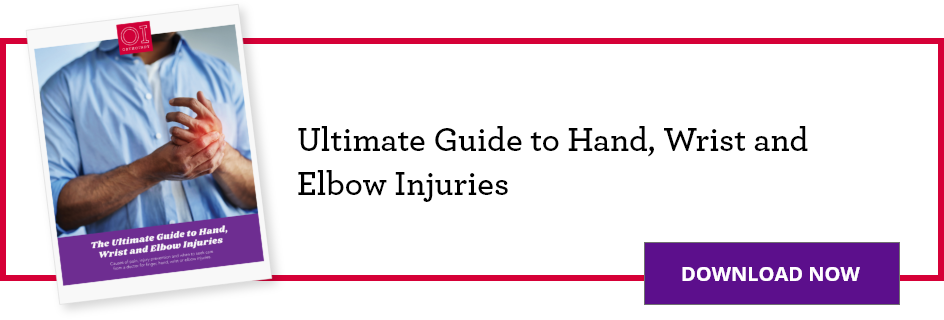THIS POST IS PART OF THE ULTIMATE GUIDE TO HAND, WRIST AND ELBOW INJURIES
Carpal tunnel syndrome is a common condition that causes pain, numbness and tingling in the hand and arm.
Anatomy
The carpal tunnel is a narrow passageway in the wrist, about an inch wide that is formed by small wrist bones called carpal bones. The roof of the tunnel is made of a transverse carpal ligament, which is a strong band of connective tissue. Because this area is very small, the tunnel has little capacity to stretch or increase in size.
One of the main nerves in the hand, the median nerve, originates as a group of nerve roots in the neck. These roots come together to form a single nerve in the arm. The median nerve goes down the arm and forearm, passes through the carpal tunnel at the wrist and goes into the hand. The nerve provides feeling in the thumb and index, middle and ring fingers. The nerve also controls the muscles around the base of the thumb.
The nine tendons that bend the fingers and thumb also travel through the carpal tunnel. These tendons are called flexor tendons.
Carpal tunnel occurs when the tunnel becomes narrowed and the median nerve is squeezed or compressed as it travels through the wrist. Overtime, it can lead to nerve damage and worsening of symptoms.
Cause
- Women and older adults are more likely to develop this condition
- Heredity
- Repetitive hand use
- Hand and wrist position during repetitive activities
- Pregnancy
- Health conditions such as diabetes, arthritis and thyroid glad imbalance
Carpal tunnel symptoms
- Numbness, tingling, burning and pain primarily in the thumb, index, middle and ring fingers
- Occasional shock-like sensation that radiates to the thumb, index, middle and ring fingers
- Pain or tingling that may travel up the forearm toward the shoulder
- Weakness and clumsiness in the hand
- Dropping things due to weakness, numbness or being unaware of where your hand is in space
Physician examination
To determine whether you have carpal tunnel, your physician will ask you for a complete medical history and when you started experiencing wrist pain, have you describe your symptoms and conduct a physical examination. An X-ray or EMG may be necessary to assess the severity of the nerve function loss.
MAKE AN APPOINTMENT WITH A HAND, WRIST OR ELBOW SPECIALIST
Carpal tunnel syndrome treatment
Carpal tunnel is a gradual process and in most cases symptoms will worsen overtime without treatment. It is important to be evaluated and diagnosed by your physician early on to slow or stop the progression of the disease. Most cases can be treated with nonsurgical methods such as:
- Bracing or splinting
- Nonsteroidal anti-inflammatory drugs such as ibuprofren
- Activity changes (Difficult if work-related)
- Nerve gliding exercises
- Steroid injections
- If symptoms do not respond after nonsurgical treatments, your physician may recommend carpal tunnel surgery.
Surgery is a release of the transverse carpal ligament effectively enlarging the carpal tunnel.
Rehabilitation
Recovery is three to six weeks usually but may vary depending on occupation.

Schedule an appointment
Your well-being is important to us. Click the button below or call us to schedule an appointment with one of our orthopedic specialists. If your injury or condition is recent, you can walk right into one of our OrthoIndy Urgent Care locations for immediate care. For rehabilitation and physical therapy, no appointment is needed to see one of our physical therapists.





